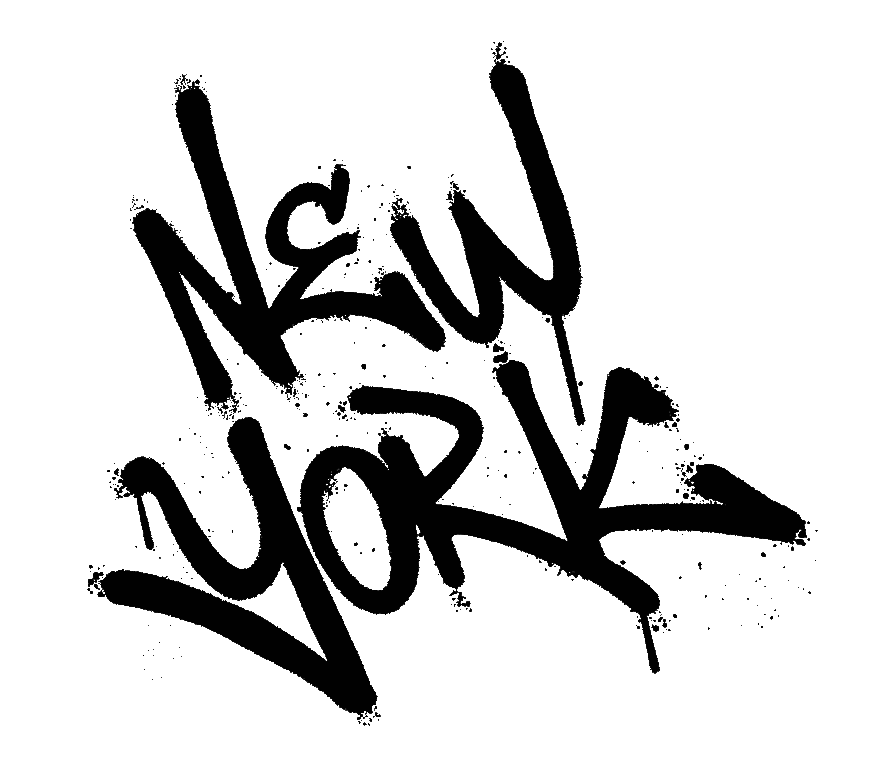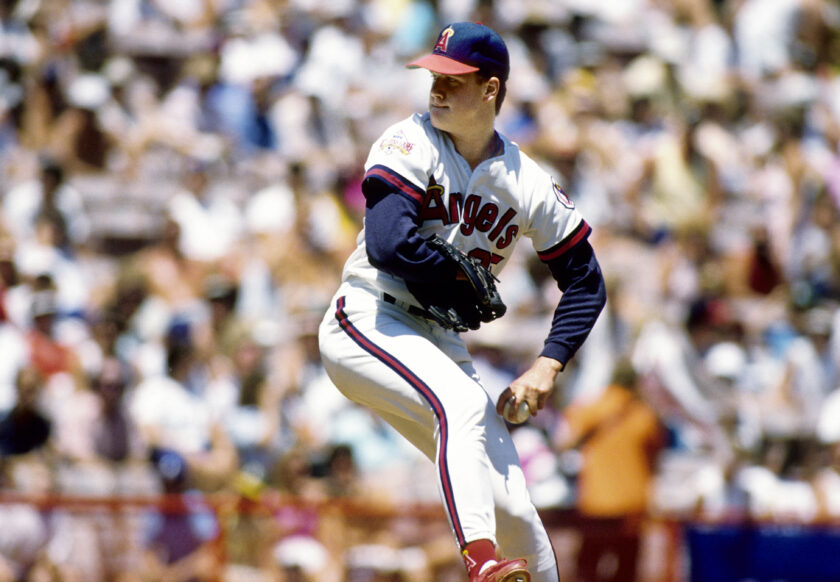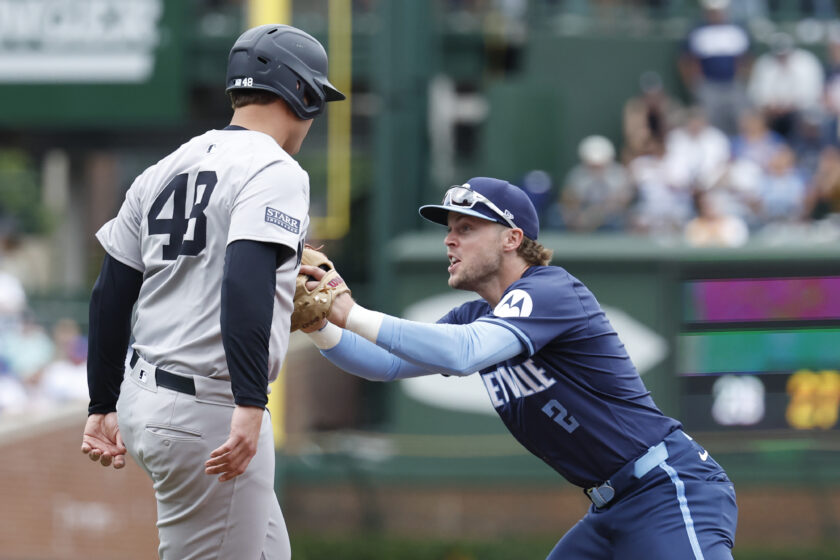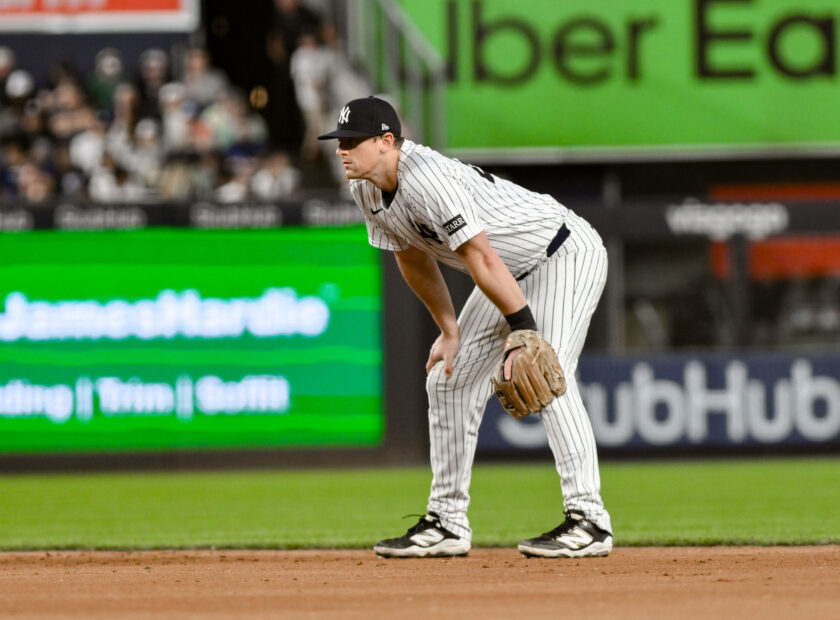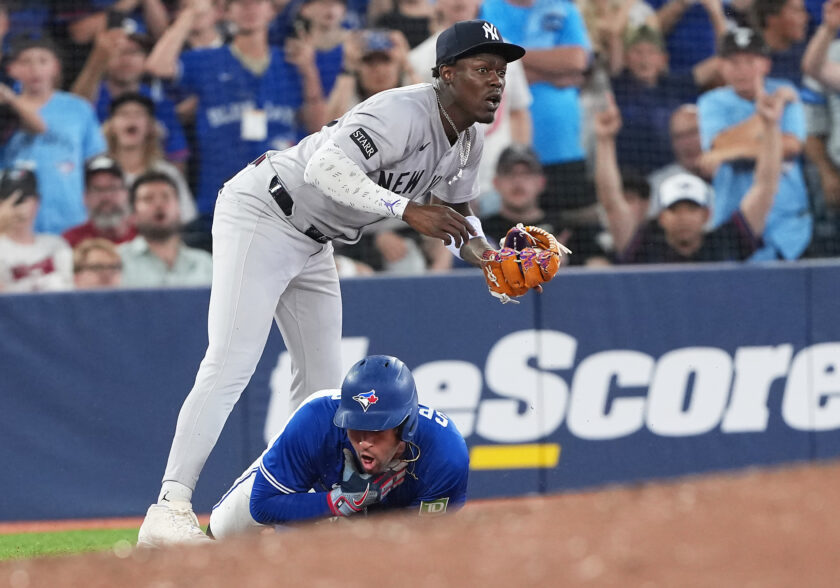10 New York Yankees starting pitchers you forgot existed

Baseball is back and so are your memories of these 10 under-the-radar New York Yankees starters of yesteryear.
[sc name=”josh-benjamin-banner” ]The New York Yankees are playing baseball this year!
That’s right, folks. After weeks of negotiations, MLB finally just implemented a 60-game season. The Yankees will open the season on July 23 against the defending World Series champion Washington Nationals. Gerrit Cole will debut with his new team against three-time Cy Young winner Max Scherzer at Nationals Park. This certainly is a match for the ages.
But not every Yankees starter has been a future Hall of Famer, nor as big an impact player as Cole. In fact, some never even got the opportunity to make an Opening Day start in pinstripes. Just the same, some cut their teeth in New York en route to success elsewhere. Others had shorter Bronx tenures but won a World Series in pinstripes anyway.
More importantly, even with spring training starting this week, these pitchers deserve further acknowledgment. That said, let’s play ball and look back on 10 forgotten New York Yankees starters.
No. 10: Ivan Nova (Yankees tenure: 2010-2016)

At 6-foot-5, Ivan Nova turned heads during a cup of coffee in the majors in 2010. He posted a 4.50 ERA in ten games, including seven starts, but posted a 2.86 ERA at Triple-A Scranton/Wilkes-Barre as a 23-year-old.
Nova then went 16-4 with a 3.70 ERA in 2011 and finished fourth in American League Rookie of the Year voting. The future certainly seemed bright, but the wheels fell off. Looking at Fangraphs, Nova moved away from his fastball and upped his curveball usage in 2012. This made him more prone to giving up home runs and his ERA ballooned to 5.02.
He returned to form with a 3.10 ERA in 2013, but then Nova underwent Tommy John surgery the following year and was never the same. He stopped throwing his slider and relied heavily on his fastball and curveball. His struggles with allowing home runs continued, and he was traded to the Pittsburgh Pirates for minor league pitching in 2016.
All in all, Nova probably could have been a great Yankee had he just trusted what got him to the majors. He posted a 4.41 ERA in pinstripes and has stuck around the majors, leading all players with 34 starts last year. When the 2020 season resumes, he will suit up with the Detroit Tigers for his 11th season.
No. 9: Don Gullett (Yankees tenure: 1977-1978)
In the mid-1970s, George Steinbrenner was a new boisterous owner unafraid to spend money. As a result, Gullett was one of the many players signed by the New York Yankees in the new free agency craze. In the fall of 1976, he received a six-year, $2 million deal to join a rotation already featuring Jim “Catfish” Hunter and star lefty Ron Guidry.
Now, this was a prime Yankees power move for two reasons. First, Gullett was just 26 years old and posted a 3.03 ERA in seven years with the Cincinnati Reds’ “Big Red Machine” teams. Second, Gullett won two World Series rings with the Reds, including one against Steinbrenner’s Yankees in 1976. In that series, Gullett pitched and won Game 1.
And in 1977, Gullett was as advertised. He went 14-4 with a 3.58 ERA across 22 starts, leading the AL in winning percentage along the way. Gullett also started Game 1 of the ’77 World Series, which the Yankees won in six games against the Los Angeles Dodgers.
Unfortunately, Gullett’s Big Apple honeymoon was short. His shoulder started giving out and he was limited to eight starts in 1978. Gullett never pitched again, but his short Yankees tenure was enough for him to retire a winner.
No. 8: Fritz Peterson (Yankees tenure: 1966-1974)

We have to talk about it, so let’s just get it out of our system. In 1973, Fritz Peterson and teammate Mike Kekich swapped wives, families, and even pets. Peterson stayed with Kekich’s wife, Suzanne, but Kekich and Marilyn Peterson did not stay together and Kekich was traded by June.
But we’re here to talk about what Peterson did on the field rather than off of it because, looking at his numbers, he was a great pitcher on some truly bad Yankees teams. He never once pitched on a playoff team in his career.
And yet, Peterson succeeded in New York despite living in Mel Stottlemyre’s shadow. 109 of his 133 wins came as a Yankee and he posted a 3.10 ERA in pinstripes. Peterson was also an excellent control pitcher, leading the majors in walks per nine innings (BB/9) three years in a row and leading the AL in it for five. In the five years preceding the wife/family swap, Peterson had a 2.88 ERA.
The sad news is Peterson then became defined by the swap and was never the same. His ERA ballooned to 3.95 in 1973, and he was moved to the Cleveland Indians in the Chris Chambliss trade early the next season. He enjoyed two more full years before shoulder troubles ended his career in 1976.
But tabloids aside, Peterson finished his career with a career BB/9 of 1.7. He was better than the teams he played on and should be recognized accordingly today.
No. 7: Rudy May (1974-1976, 1980-1983)
Unless you comb through the baseball annals looking for his name, Rudy May is someone you can easily miss. The Oakland native debuted with the California Angels at age 20 in 1965, but then spent the next three years in the minors. The lefty then became a reliable arm for the Angels, and the Yankees purchased his contract in 1974.
May would post a 3.03 ERA for New York in 1975, but was then sent to the Baltimore Orioles in a blockbuster trade the following year. Along with May, Baltimore received a trio of future franchise favorites: Tippy Martinez, Rick Dempsey, and Scott McGregor. The Yankees’ return was highlighted by pitchers Doyle Alexander and Grant Jackson, who both signed elsewhere in free agency at season’s end.
Meanwhile, May continued to provide consistency for the Orioles and later Montreal Expos, both as a starter and reliever. He returned to the Yankees in free agency in 1980 and led the AL with a 2.46 ERA at 35 years old. May also led the league in FIP, WHIP, and ERA+. He retired at the end of the contract in 1983, posting a 3.12 ERA in 184 appearances as a Yankee.
Rudy May wasn’t ever a star player, nor was he ever an All-Star. He was, however, reliable in any role.
No. 6: Jimmy Key (Yankees tenure: 1993-1996)

Every New York Yankees fan has good things to say about Jimmy Key. The lanky lefty signed a four-year deal worth nearly $17 million to join the Bronx Bombers following the 1992 season. Key had spent the first nine years of his career with the Toronto Blue Jays and just won a World Series ring. Adding him as the new ace of the staff just made sense to general manager Gene Michael.
And Key performed as advertised early on. He went 18-6 with a 3.00 ERA in 1993, finishing fourth in AL Cy Young voting. Key also led the majors with 17 wins and a 3.27 ERA in the strike-shortened ’94 season. However, he finished second in Cy Young voting behind future teammate David Cone.
Key’s reputation as an innings eater then caught up with him. He missed all but five games of the 1995 season with a torn rotator cuff. However, despite bleak prospects, he returned to make 30 starts in 1996. Most important of all, Key was the winning pitcher in the decisive Game 6 of the World Series. At long last, in his final appearance as a Yankee, he ended the team’s championship drought.
Jimmy Key then spent two years with the Baltimore Orioles before retiring, including one final All-Star season in 1997. Still, his signing with the Yankees was a sign that times were changing. In his curtain call, he made sure it happened.
No. 5: Hiroki Kuroda (Yankees tenure: 2012-2014)

Hiroki Kuroda wasn’t with the New York Yankees for long, but was as reliable as they come. The Japanese righty spent his first four MLB seasons with the Dodgers after 11 years with the Hiroshima Carp. Out west, he spun a 3.45 ERA and averaged nearly 175 innings a season.
Kuroda then inked a one-year, $10 million deal with the Yankees just before his 37th birthday. He was so effective, he signed two more one-year deals over the next two years. Even as he pushed 40, Kuroda averaged 206.6 innings per year in New York and managed a 3.44 ERA.
But Hiroki Kuroda was more than just an effective pitcher for the New York Yankees. Though the team made the playoffs in 2012, a rebuild was coming. His ability to go deep into games and give the bullpen a rest whenever he took his turn was something the Yankees sorely needed in 2013 and 2014.
And Kuroda’s Yankees tenure ending wasn’t the end for him either. Despite being 40 years old, he returned to the Carp for two more years and was still remarkably effective.
No. 4: Al Downing (Yankees tenure: 1961-1969)

New Jersey native Al Downing is remembered for the wrong reason. On April 8, 1974, with his Los Angeles Dodgers in Atlanta to face the Braves, Downing was on the mound when Hank Aaron hit his then-record 715th career home run. Downing was 33 years old and already in the twilight of his career.
But Al Downing was so much more than that as a player. Before he was giving up historical homers, he was the first African-American pitcher in New York Yankees history. In 1963, his true rookie year after cups of coffee the previous two, he led the AL in K/9 and the majors in H/9.
The following year, Downing would lead the league in strikeouts before the Yankees entered a hard rebuild in 1965. He posted a 3.23 ERA in pinstripes to go with 72 wins. By the end of his run with the Yankees, injuries had him bouncing between the rotation and bullpen. After the 1969 season, he was traded to the Oakland Athletics.
But Downing’s story wasn’t over. Oakland traded him to the Milwaukee Brewers in June 1970, and the Brewers traded him to the Dodgers prior to the 1971 season. Downing won 20 games and was the NL Comeback Player of the Year for that season. He retired in 1977 and went into broadcasting.
His defining moment may not have been in New York, but Al Downing still bled pinstripes during his prime years.
No. 3: Tommy John (Yankees tenure: 1979-1982, 1986-1989)

Tommy John was more than just the namesake of a revolutionary arm surgery which has since saved countless pitchers’ careers. Aside from getting his elbow reconstructed, John enjoyed a career that lasted an eye-popping 26 years with six different teams.
The Yankees were one of those six teams and John enjoyed two separate stints in the Bronx. His first began when, at age 35, he signed with New York in free agency. Age aside, John proved worth the investment and went 52-26 with a 3.07 ERA in the first three years. John was also instrumental in getting the Yankees to the 1981 World Series, and his being pulled early despite pitching well in Game 6 may have cost New York a Game 7.
John was then traded to the California Angels near the end of the 1982 season, but then returned to New York in free agency in 1986. He spent the final four years of his career with the Yankees. Though he pitched nearly 500 innings over that stretch, he had become a novelty and was known more for his age showing in the video above than he was prior accomplishments.
Still, nearly a third of his 288 career wins came with the Yankees, and John also posted a 3.59 ERA in New York. That he was able to accomplish so much at an age when most players are thinking about life after baseball is unbelievable. Had he been left in to pitch in Game 6 in 1981, perhaps he could have won that ever-elusive World Series ring.
No. 2: Phil Niekro (Yankees tenure: 1984-1985)

Phil Niekro had a weird path to New York. He spent the first not one but two decades of his career with the Atlanta Braves as his being a knuckleballer made him durable and prolonged his career. He signed a two-year deal to pitch for the Yankees, and turned 45 two days after Opening Day in 1984.
But Niekro still had some gas in the tank. He won 32 games in those two seasons and posted a 3.59 ERA. Niekro also notched his 3,000th career strikeout with the Yankees. On the last day of the 1985 season, the 46-year-old shut out the Blue Jays to pick up his 300th win. The crazy part? Niekro pitched two more seasons before ending his Hall of Fame career.
Was Niekro an all-time New York Yankees great? Of course not. In fact, he probably had more in common with the coaching staff than he did with some of his teammates during his Bronx tenure. But the fact remains Niekro punched his ticket to Cooperstown as a Yankee. He wasn’t around long, but made his time count.
No. 1: Chien-Ming Wang (Yankees tenure: 2005-2009)

No New York Yankees fan likes talking about Chien-Ming Wang. It’s just too painful. Some, myself included, would rather be strapped to a chair and forced to watch My Girl for 24 hours than think of what Wang’s career could have been.
But therein lies why Wang has the top spot on this list. His dominant run was over before it could really begin. The Taiwanese righty debuted for the Yankees in 2005 at 25 years old and went 8-5 with a 4.02 ERA in 18 games (17 starts). He only managed 3.6 K/9, but Wang made up for it with an unbelievable groundball rate (GB%) of 63.9%.
The true excitement began the very next year. Wang led the majors with 19 wins and finished second in AL Cy Young voting. He likely would have won, but he managed just 76 strikeouts in 218 innings. Still, Wang had a GB% of 62.8 and won 19 games again in 2007.
And Wang was 8-2 when it all came crashing down on June 15, 2008. The Yankees were playing the Houston Astros, then part of the National League, and Wang suffered a Lisfranc injury when running the bases. He missed the rest of the season, but was expected to be ready for 2009.
This is where the story turns sad. The injury forced Wang to overcompensate with his mechanics, specifically his release point. He then threw out his shoulder trying to right himself and missed all but 12 games of 2009. He has since briefly resurfaced with Washington, Toronto, and the Kansas City Royals, but never at the same level.
Had Wang not gotten injured, perhaps fans would better remember him.
Josh Benjamin has been a staff writer at ESNY since 2018. He has had opinions about everything, especially the Yankees and Knicks. He co-hosts the “Bleacher Creatures” podcast and is always looking for new pieces of sports history to uncover, usually with a Yankee Tavern chicken parm sub in hand.
